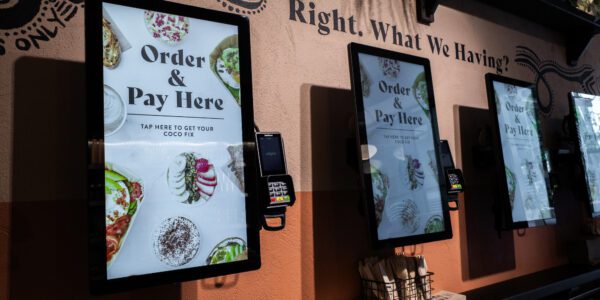7 incredible benefits of using self service kiosks in your restaurant
Self serve kiosks aren’t just for McDonalds any more. Discover the financial and operational benefits of kiosks and why they might be right for your restaurant.

Looking to improve restaurant operations? Find out how to reduce wasted time, save costs and increase revenue.
It’s no secret that the hospitality industry can feel like an uphill battle. Rising costs – whether it’s produce, supplies or utilities – are eating into already thin margins, putting unparalleled pressure on restaurants. Skilled labour is hard to find and retain, and consumer behaviours are shifting rapidly.
It’s never been more important for restaurants to make sure they’re running as smoothly, efficiently and profitably as possible if they want to ensure long-term success. Restaurants that adapt, survive.
Sound challenging? We know, but we’ve got the (not so) secret recipe to making it happen. Here are our six hacks to improve restaurant operations.

Multi-channel ordering promised to be a game-changer for businesses. And while offering multiple options like self-order kiosks, mobile order and pay, and third-party delivery platforms like Deliveroo is certainly a growth opportunity, it’s also the source of major menu management headaches.
Updating menus was simple when guests only had one option to order food – in-store via a staff member. Nowadays, updating menus across multiple channels takes restaurant teams hours, often eating into their evenings. Put simply, it’s a time-guzzler that businesses can’t afford.

Thankfully, there’s a solution – centralising order management means you can make menu changes all in one place, sending them out to every single channel. Just like that, menu management is taken care of and you can refocus your time on more important things. Like growing your restaurant. Or sleeping through the night again.
And we’re here to help.
Book a chat with a tech expert to discover how to make your business more profitable, efficient, and easy to manage by simplifying how you operate.
Menus offer even more potential for smooth restaurant operations. With digitalisation, a menu no longer just sits there, it works harder and smarter by maximising profit.
Begin by analysing your digital menu items. Find out how profitable and how popular each item is by using your data and reporting tools to look at how much (or how little) of each item has sold during a specific period of time.
You can then strategically position specific items by upselling, introducing basket recommendations, or allowing for customisation on orders. These data-backed changes help you squeeze the most revenue out of every transaction.

Many businesses are finding it increasingly difficult to find and hold onto staff. Rising costs at every corner and minimum wage increases have pushed restaurant owners to try and alleviate some of that financial pressure by reducing their workforce. But this comes at a cost to the customer experience they offer guests.
The remaining staff are often bogged down with admin tasks like manually taking orders or sorting third-party delivery orders that seem to come through thicker and faster every day. And while staff are stuck juggling these tasks, they’re not focused on guests.
The fix? Agile restaurant operations that enable your reduced workforce to focus on true hospitality.

By bringing in tech to handle this admin work, your staff can focus on value-added jobs instead. They can greet guests and be on hand to help service run smoothly while everything else carries on in the background.

Much like having menus on multiple channels, restaurant operators are also dealing with data from multiple streams. They’re analysing menu and regional performance, loyalty scheme data, footfall and more.
This is a lot to keep track of when trying to understand how your entire operation is running. Many restaurants are dealing with fragmented tech stacks comprising of complicated integrations and individual point solutions, which makes it impossible to see all of this data at once. Operators must analyse data between different order channels, on different accounts, using several different reports and then spend hours trying to collate this information into reports themselves.
But with a single Order Management System, all this data can be centralised and organised in one place, saving time and simplifying the operation. It handles all order channels, fulfilment and loyalty in one system, including data from all locations and channels. Making data-backed decisions becomes a piece of cake.
Decorating the kitchen with paper tickets became a thing of the past with the introduction of Kitchen Management Systems, but that wasn’t the end of kitchen complications.
Orders are now coming through multiple channels, from kiosks to Click & Collect or third-party delivery partners. Each of these channels often has its own Kitchen Management System. Suddenly, what was once an innovative solution is a source of kitchen chaos as staff must deal with multiple Kitchen Display Screen tablets at once, affecting the quality and speed of items coming out and going to diners and ultimately damaging the customer experience.
The only way to combat this and relieve the pressure on the kitchen staff is one single Kitchen Management System, pulling orders from every channel and displaying them in one place. It means orders come in on time, accurately, and your teams have the chance to get them right and get them out on time, too.
Your kitchen is then well-equipped to fulfill increased orders as your business grows, rather than having to battle a system growing increasingly chaotic.

The more point solutions your restaurant has, the more points of failure you add to your operation. You hamstring your growth by reducing your own chances of a smooth-running operation before it has even begun.
If each point solution has 99% uptime per year, and you have seven point solutions, your entire operation only has 93% uptime.
By centralising your operations into one single order management system, you rely on fewer point solutions – reducing the compounded risk of both downtime and tech problems. This is how you ensure a more robust and reliable operation for yourself and your team.
Ready to centralise your operations? Book a demo and find out how an order management system can help you increase revenue, operate more efficiently, and grow your business.
Self serve kiosks aren’t just for McDonalds any more. Discover the financial and operational benefits of kiosks and why they might be right for your restaurant.

Learn the benefits of centralising your hospitality data, and how easy-to-read, real-time reports will help you scale your business.

Innovating Hospitality: Lessons from the Retail Sector
